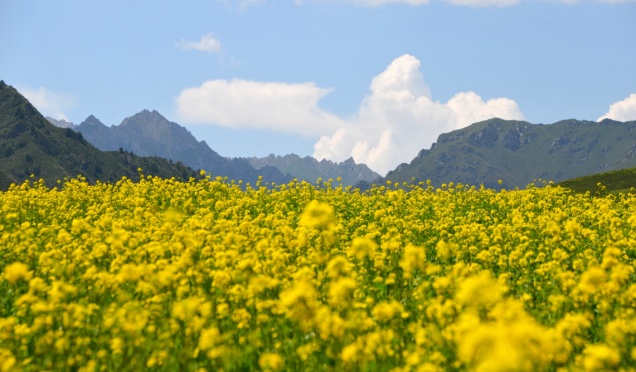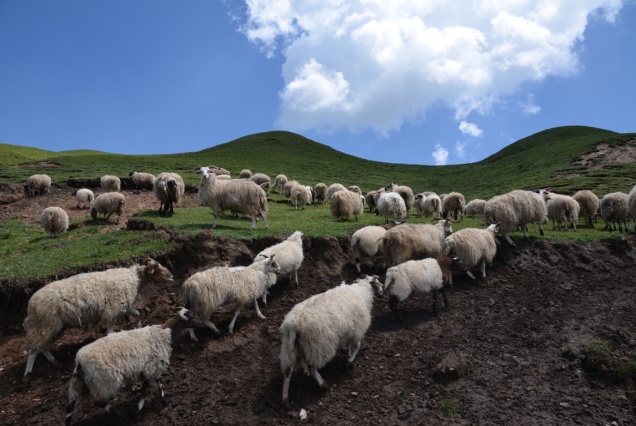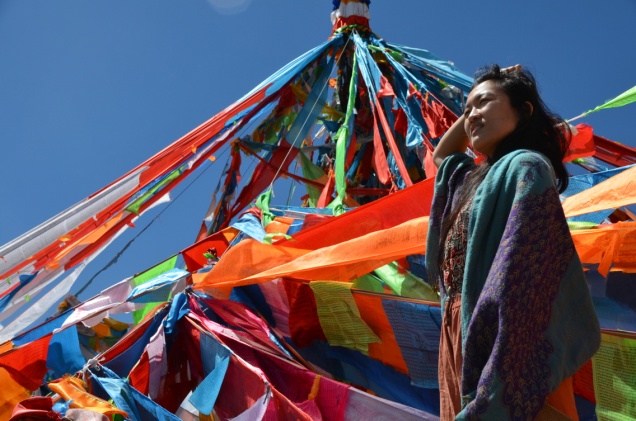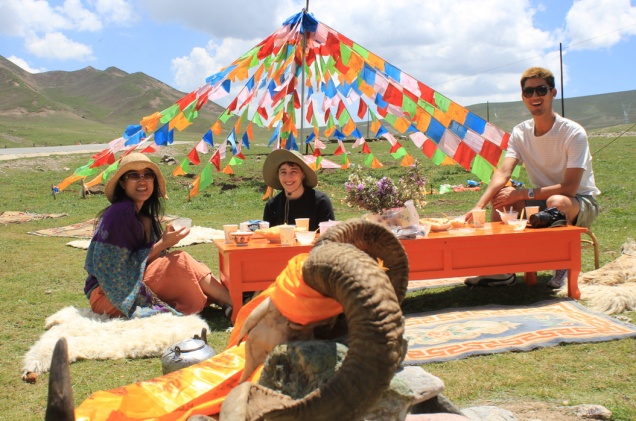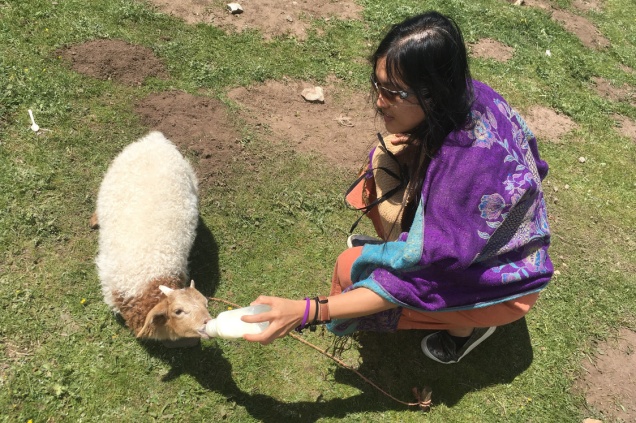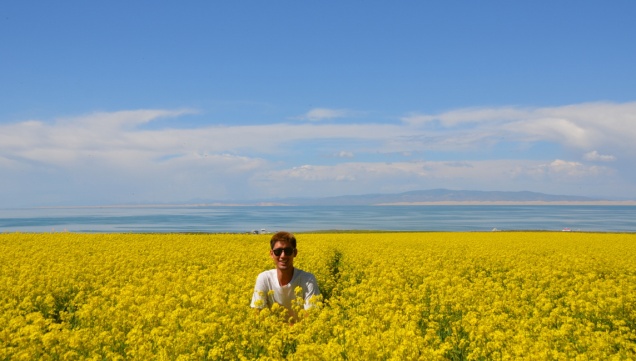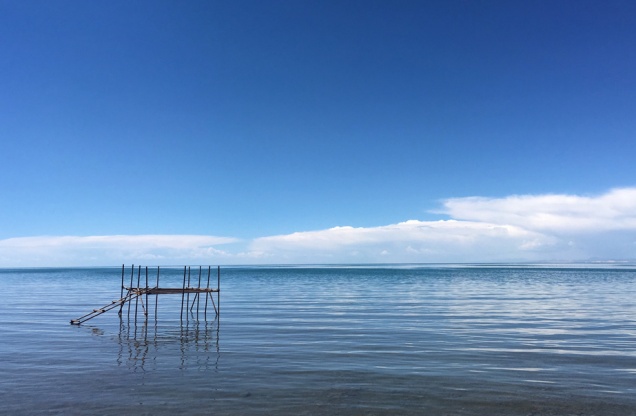Xining: Tibetan Medicine Museum
Earlier this autumn I made a weekend trip to Xining, taking the 70 minute bullet train. Xining is the capital of Qinghai province, and the gateway to areas of China with heavier Tibetan influence.
I was there to visit the Tibetan Medicine Museum of China to see the Great Thangka. A Thangka (tangkasnet) is a Tibetan Buddhist painting done on cotton or silk. In this style of art, there is always one large figure in the center, surrounded by dozens of smaller demi-gods, animals, and monks depicting a Buddhist story. Here is an example, courtesy of Wikipedia:
The thangka is always colorful and ornate, meticulously painted with layers of blue ocean waves, deep red temple facades, and gold or silver lining saved for clouds and deities.
What makes the Great Thangka special is its sheer size and length – this is a scroll painting 618 meters (2,000+ feet!!!) in length and 1,000 kg in weight – which took 300 artists over 25 years to complete. Walking into the exhibit was a mind-blowing experience.
Wall after wall, room after room, was this never-ending scroll painting as far as the eye could see. Every square inch of visible surface-area was covered in colors and stories- there were elephants, tortured human skeletons, vultures, blue-skinned fire demons, dragons, and historical figures important to Tibetan Buddhism.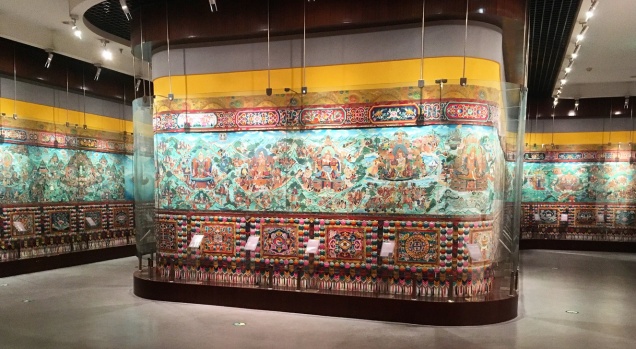
It was a quiet Saturday morning and I had the entire exhibit to myself. In retrospect I should have requested a guide to help me further appreciate the artwork, to better understand the major themes and fables depicted. 
Had it not been for the green arrows on the floor guiding visitors through the museum, I definitely would have been lost at some point. The experience was similar to wandering through a corn maze, only slightly more artistic and lacking screaming children.
Here is a floor map of the exhibit; from above it looks a bit like our large intestines (I drew a yellow line to helpfully indicate the thangka snaking through the museum).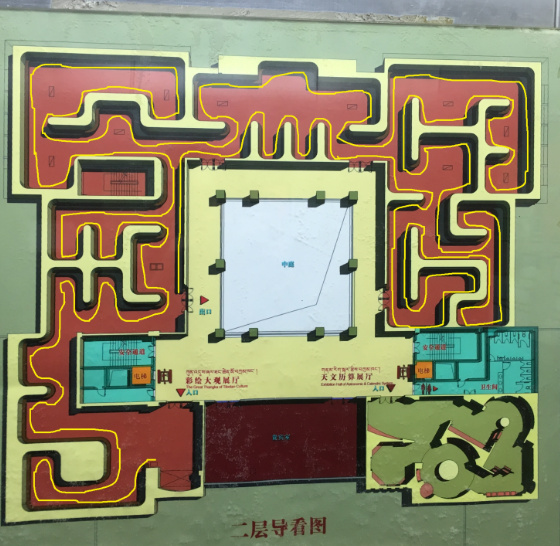
I am really curious about the logistics of outlining, painting, storing, transporting, and installing the Great Thangka. Researching this might just be my Peace Corps secondary project, instead of fixing up the dreaded “Book Nook”.
Zhangye: Danxia Geopark and the Giant Buddha
Several weeks later I again headed north-west from Lanzhou for three and a half hours via bullet train, this time to Zhangye.
Zhangye is famous for the Danxia National Geopark, a rock formation landscape similar to the Grand Canyon. With good weather and angled sunlight, the rich colors of the earth streak through the mountainside in reds, yellows, cream, and every color in between.
Danxia is about forty minutes away from Zhangye downtown by private car. After arriving at the geopark, I hitched a ride on the park bus that came every ten minutes or so, stopping at each viewpoint to admire various rock formations.
Chinese love giving ridiculous, long-winded names to odd shaped rocks on mountains and hills- the Danxia Geopark is no different. Below are some fancy titles for the sculpted landscape, and if you squint hard enough, maybe you could see a scallop or monkey, but I honestly just saw dirt-colored cliffs.
- Huge Scallop Rock Cumulus
- Colorful Meeting Fairy Deck
- Spirit Monkey View Sea
- Supernatural Tortoise Looks at the Sky
Also worth noting that every image on Google has been photoshopped and saturated beyond reality, and what I saw with my eyes looked nothing like what a visitor may have expected, if they were to believe Google.
The other must-see landmark in Zhangye is the Giant Sleeping Buddha (张掖大佛寺). This slumbering sculpture is the largest of its kind in China – and thankfully, has barely been touched since its creation in the Western Xia Dynasty 900+ years ago.
The Buddha is held together by a hollow wooden frame coated in a layer of clay, and painted over. A panorama shows its true scale: 157 feet long x 24 feet wide at its highest (shoulder to shoulder). He is guarded by ten disciples behind him, and two on either side of his head and feet.
No photography was allowed inside, so these are Google photos. Behind the statue on the wall were Ming Dynasty murals retelling scenes from Journey to the West (interestingly, the wall paintings were completed before the book 西游记 was written, so many of these tales about the Monkey King existed along the Silk Road well before they reached the rest of China!). There’s also a legend that Kublai Khan was born here, but so far there’s little evidence of this.
The temple exterior is unadorned and unpainted. There are banners along the entrance pillars with a beautiful poem, written in traditional Chinese characters:
Sleep Buddha, long may you slumber
Sleep 1,000 years
Slumber forever, do not awaken
Those who ask, question forever
Question 100 centuries
Never ask, and you will never know
Of course I made a sketch of this too, with the poem written in gold ink glimmering against a black midnight sky, overlooking Zhangye’s Giant Buddha. May he sleep for another 100 centuries!

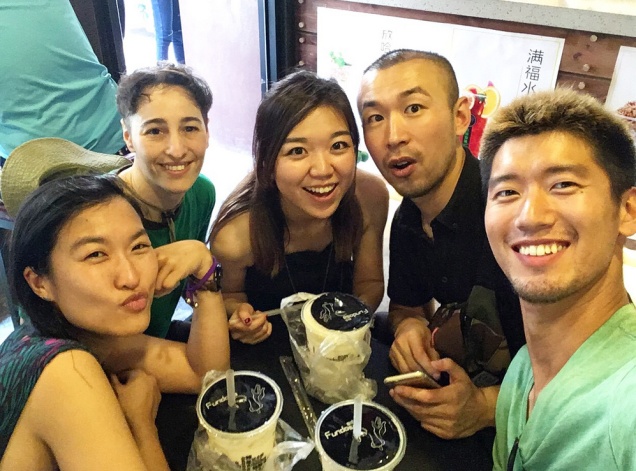

 It turns out, this year MenYuan (not Biandukou, where we were headed) had the highest concentration of canola flowers, so the view from the train was the best of all! I’ll be back next year…
It turns out, this year MenYuan (not Biandukou, where we were headed) had the highest concentration of canola flowers, so the view from the train was the best of all! I’ll be back next year…
